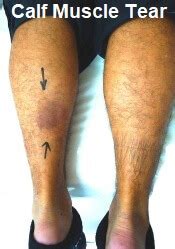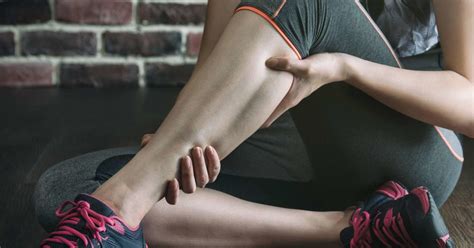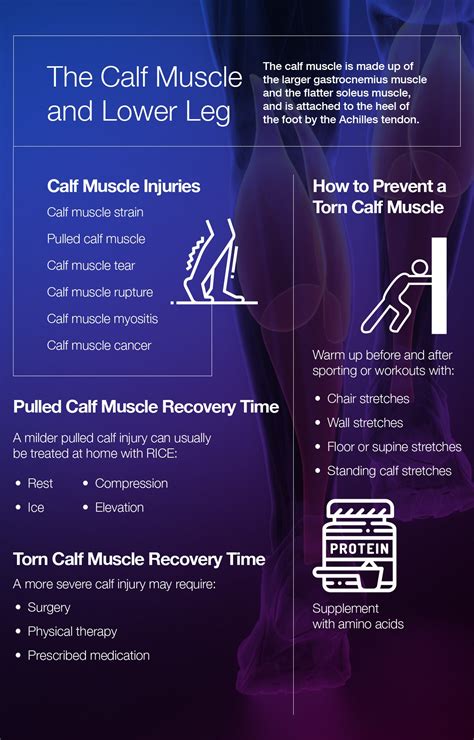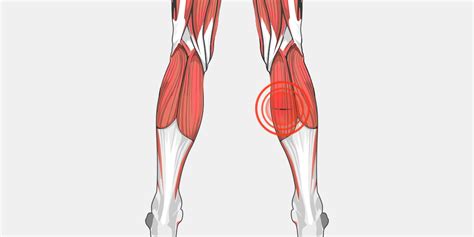Intro
Identify pulled calf muscle symptoms, including pain, swelling, and bruising, and learn about strains, tears, and treatment options for calf injuries, leg strains, and muscle pulls.
A pulled calf muscle can be a painful and debilitating injury, often occurring suddenly and without warning. It is essential to recognize the symptoms of a pulled calf muscle to seek proper treatment and prevent further complications. Calf muscle strains are common among athletes, particularly those involved in sports that require running, jumping, or quick changes of direction. However, anyone can experience a pulled calf muscle, regardless of their activity level. Understanding the symptoms and causes of this injury can help individuals take preventive measures and seek medical attention when necessary.
The calf muscles, comprising the gastrocnemius and soleus muscles, play a crucial role in ankle movement and stability. When these muscles are stretched or torn, it can lead to a range of symptoms, from mild discomfort to severe pain and limited mobility. In some cases, a pulled calf muscle can be a recurring issue, particularly if the underlying causes are not addressed. Factors such as poor foot mechanics, inadequate warm-up routines, and muscle imbalances can contribute to the development of calf muscle strains. By recognizing the symptoms and understanding the causes, individuals can take proactive steps to prevent pulled calf muscles and promote overall lower leg health.
Pulled calf muscle symptoms can vary in severity, but common signs include sudden pain, swelling, and limited mobility. In some cases, a popping or snapping sound may be heard at the time of injury, indicating a more severe muscle tear. The pain associated with a pulled calf muscle can range from a dull ache to a sharp, stabbing sensation, often worsening with activity and improving with rest. As the injury heals, it is essential to gradually introduce stretching and strengthening exercises to promote full recovery and prevent future occurrences. A comprehensive treatment plan, incorporating rest, ice, compression, and elevation (RICE), as well as physical therapy and orthotics, can help alleviate symptoms and support the healing process.
Pulled Calf Muscle Causes and Risk Factors

Common Causes of Pulled Calf Muscles
Some common causes of pulled calf muscles include: * Overuse or repetitive strain on the calf muscles * Poor foot mechanics, such as flat feet or high arches * Inadequate warm-up routines or insufficient stretching * Muscle imbalances, such as tight hamstrings or weak ankle muscles * Sudden changes in activity level or intensity * Wearing improper footwear or using inadequate equipmentPulled Calf Muscle Symptoms and Diagnosis

Common Symptoms of Pulled Calf Muscles
Some common symptoms of pulled calf muscles include: * Sudden pain or discomfort in the calf area * Swelling or bruising in the affected area * Limited mobility or stiffness in the ankle or foot * Pain or stiffness that worsens with activity and improves with rest * A popping or snapping sound at the time of injury * Weakness or fatigue in the calf musclesTreatment and Management of Pulled Calf Muscles

Treatment Options for Pulled Calf Muscles
Some treatment options for pulled calf muscles include: * Rest, ice, compression, and elevation (RICE) * Physical therapy, including stretching and strengthening exercises * Orthotics, such as shoe inserts or ankle braces * Pain management, including medication or injections * Surgery, in severe cases, to repair a torn muscle or tendonPrevention and Recovery

Preventive Measures for Pulled Calf Muscles
Some preventive measures for pulled calf muscles include: * Incorporating stretching and strengthening exercises into a training routine * Wearing proper footwear and using adequate equipment * Gradually increasing activity level and intensity * Avoiding overuse or repetitive strain on the calf muscles * Maintaining good foot mechanics and ankle mobilityComplications and Long-Term Effects

Potential Complications of Pulled Calf Muscles
Some potential complications of pulled calf muscles include: * Chronic pain and limited mobility * Decreased athletic performance and functionality * Muscle rupture or tendonitis * Persistent stiffness and limited range of motion * Increased risk of future injuries or complicationsConclusion and Next Steps

We invite you to share your experiences and questions about pulled calf muscles in the comments below. Have you or someone you know experienced a pulled calf muscle? What steps did you take to treat and manage the injury? Share your story and help others understand the importance of proper treatment and prevention.
What are the common causes of pulled calf muscles?
+Pulled calf muscles can be caused by overuse, poor foot mechanics, inadequate warm-up routines, and muscle imbalances. Athletes who participate in sports that involve running, jumping, or quick changes of direction are at a higher risk of experiencing a pulled calf muscle.
How can I prevent pulled calf muscles?
+To prevent pulled calf muscles, incorporate stretching and strengthening exercises into your training routine, wear proper footwear, and gradually increase activity level and intensity. Avoid overuse or repetitive strain on the calf muscles, and maintain good foot mechanics and ankle mobility.
What are the symptoms of a pulled calf muscle?
+Symptoms of a pulled calf muscle can include sudden pain, swelling, and limited mobility. In some cases, a popping or snapping sound may be heard at the time of injury, indicating a more severe muscle tear. The pain associated with a pulled calf muscle can range from a dull ache to a sharp, stabbing sensation, often worsening with activity and improving with rest.
How can I treat a pulled calf muscle?
+Treatment for pulled calf muscles typically involves a combination of rest, ice, compression, and elevation (RICE), as well as physical therapy and orthotics. The goal of treatment is to reduce pain and inflammation, promote healing, and prevent future occurrences. In severe cases, surgery may be necessary to repair a torn muscle or tendon.
What are the potential complications of pulled calf muscles?
+If left untreated or poorly managed, pulled calf muscles can lead to chronic pain, limited mobility, and decreased athletic performance. In severe cases, a pulled calf muscle can lead to more serious complications, such as muscle rupture or tendonitis. Long-term effects of pulled calf muscles can include persistent pain, stiffness, and limited mobility.
